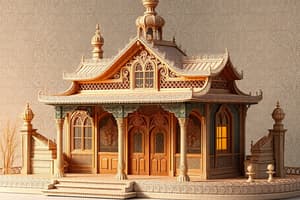Podcast
Questions and Answers
What allows digital devices to be used for various applications while maintaining the same underlying hardware?
What allows digital devices to be used for various applications while maintaining the same underlying hardware?
- Programmable software (correct)
- Advanced manufacturing techniques
- Changing physical components
- Higher processing speeds
What is a primary function of error-correcting codes in digital systems?
What is a primary function of error-correcting codes in digital systems?
- Automatically identifying and correcting errors (correct)
- Enhancing the physical size of the components
- Increasing the storage capacity of the devices
- Reducing the number of operations performed
Which statement describes a benefit of digital integrated circuits?
Which statement describes a benefit of digital integrated circuits?
- They require more physical space in devices.
- They operate at reduced costs due to higher transistor density. (correct)
- They primarily function in analog systems.
- They slow down the operation of digital devices.
Which of the following is NOT a characteristic of a digital computer?
Which of the following is NOT a characteristic of a digital computer?
How do advances in digital integrated circuit technology impact the pricing of digital devices?
How do advances in digital integrated circuit technology impact the pricing of digital devices?
What feature of digital systems contributes to their reliability?
What feature of digital systems contributes to their reliability?
What can be concluded about the speed of equipment built with digital integrated circuits?
What can be concluded about the speed of equipment built with digital integrated circuits?
Which of the following best describes the operational principle of a digital system?
Which of the following best describes the operational principle of a digital system?
What term is used to describe the ability of digital systems to process discrete elements of information?
What term is used to describe the ability of digital systems to process discrete elements of information?
Which of the following is NOT a typical application of digital systems?
Which of the following is NOT a typical application of digital systems?
What type of information do digital systems manipulate?
What type of information do digital systems manipulate?
What is the most notable characteristic of a general-purpose digital computer?
What is the most notable characteristic of a general-purpose digital computer?
How do digital systems typically represent data?
How do digital systems typically represent data?
In what way do graphical user interfaces (GUIs) simplify user interaction with digital devices?
In what way do graphical user interfaces (GUIs) simplify user interaction with digital devices?
Which component of a general-purpose digital computer is primarily responsible for performing data-processing operations?
Which component of a general-purpose digital computer is primarily responsible for performing data-processing operations?
Which device is responsible for converting analog quantities into digital representations?
Which device is responsible for converting analog quantities into digital representations?
What is a critical role of digital systems in communication?
What is a critical role of digital systems in communication?
Which of the following represents an example of discrete data in a payroll schedule?
Which of the following represents an example of discrete data in a payroll schedule?
Which statement best describes the transition into the digital age?
Which statement best describes the transition into the digital age?
What aspect does the generality of a digital computer allow users to do?
What aspect does the generality of a digital computer allow users to do?
Which of these is NOT typically considered a part of a digital computer's major components?
Which of these is NOT typically considered a part of a digital computer's major components?
What role does the memory unit of a digital computer play?
What role does the memory unit of a digital computer play?
Which of the following describes how continuous processes may be represented in digital systems?
Which of the following describes how continuous processes may be represented in digital systems?
Why are binary systems favored in modern technology?
Why are binary systems favored in modern technology?
Flashcards are hidden until you start studying
Study Notes
Digital Systems Overview
- Digital systems play a crucial role in modern life, marking the beginning of the digital age.
- Applications include communication, business transactions, traffic control, spacecraft guidance, medical treatment, weather monitoring, and the Internet.
- Common devices: digital telephones, televisions, disks (DVDs), cameras, and computers.
Features of Digital Devices
- Digital computers can perform arithmetic computations and logical operations.
- They are programmable, allowing the same hardware to be reused for various applications, which minimizes development costs.
- Advances in digital integrated circuits lead to dramatic cost reductions as more transistors can be placed on silicon chips.
Performance and Reliability
- Digital devices execute hundreds of millions of operations per second, enhancing processing speed.
- Reliability is achieved using error-correcting codes. An example includes DVDs, where digital samples are corrected for errors during playback.
Characteristics of Digital Systems
- Digital systems manipulate discrete information represented in binary form.
- They can process finite sets of data, whether naturally discrete (like payroll data) or quantized from continuous processes (like scientific measurements).
- Analog-to-digital converters enable the representation of continuous data in digital format.
Structure of a Digital Computer
- Core components include the memory unit, central processing unit (CPU), and input-output units.
- The memory unit stores programs, inputs, outputs, and intermediate data necessary for processing.
- The CPU is responsible for executing arithmetic and data-processing operations defined by programs.
- Input devices (e.g., keyboards) transfer data into memory, while output devices (e.g., printers) deliver results to the user.
General-Purpose Digital Computers
- These computers are versatile and can adapt to different tasks by allowing users to modify programs and data.
- They support a wide range of applications due to their generality and flexibility in information processing.
Studying That Suits You
Use AI to generate personalized quizzes and flashcards to suit your learning preferences.




